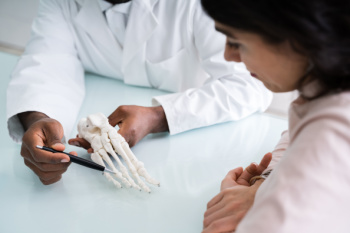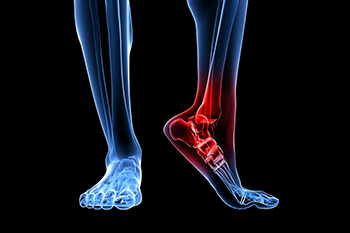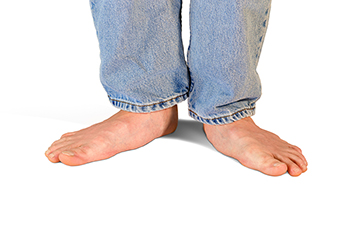Connect With Us
Blog
Items filtered by date: September 2024
Podiatrists and Foot Conditions They Treat

A podiatrist is a medical specialist focused on diagnosing and treating conditions related to the feet, ankles, and lower legs. This healthcare professional addresses a wide range of issues, including common conditions such as bunions, plantar fasciitis, and heel spurs. They also manage injuries like fractures and sprains, as well as chronic conditions such as diabetes-related foot problems and arthritis. Podiatrists are skilled in prescribing orthotics and providing treatments to alleviate pain and restore function. Some of them also perform surgeries. They play a vital role in preventive care, offering guidance on proper footwear and foot hygiene. If you have any type of foot or ankle pain, it is suggested that you visit a podiatrist who can accurately diagnose the cause, and offer an effective treatment plan.
If you are experiencing pain in the feet or ankles, don’t join the stubborn majority refusing treatment. Feel free to contact Dr. Richard Silverstein from Union Foot Care. Our doctor can provide the care you need to keep you pain-free and on your feet.
What Is a Podiatrist?
Someone would seek the care of a podiatrist if they have suffered a foot injury or have common foot ailments such as heal spurs, bunions, arch problems, deformities, ingrown toenails, corns, foot and ankle problems, etc.
Podiatric Treatment
A podiatrist will treat the problematic areas of the feet, ankle or lower leg by prescribing the following:
- Physical therapy
- Drugs
- Orthotic inserts or soles
- Surgery on lower extremity fractures
A common podiatric procedure a podiatrist will use is a scanner or force plate which will allow the podiatrist to know the designs of orthotics. Patients are then told to follow a series of tasks to complete the treatment. The computer will scan the foot a see which areas show weight distribution and pressure points. The podiatrist will read the analysis and then determine which treatment plans are available.
If you have any questions please feel free to contact our office located in Havre de Grace, MD . We offer the newest diagnostic and treatment technologies for all your foot and ankle needs.
What Leads to Heel Pain?

Heel pain can stem from various causes, leading to significant discomfort and disruption in daily activities. One of the most prevalent causes is plantar fasciitis, where inflammation of the tissue connecting your heel to your toes leads to sharp pain. Other possible culprits include heel spurs, which are bony growths that develop on the heel bone, and Achilles tendinitis, an inflammation of the tendon connecting your calf muscles to your heel. Complications from untreated heel pain include an altered gait, which might lead to additional strain on other joints and muscles, potentially causing further issues. Proper diagnosis is key to addressing the root cause of heel pain and preventing ongoing problems. If you are experiencing persistent heel pain, it is suggested you make an appointment with a podiatrist who can provide a comprehensive evaluation and recommend an effective treatment plan to relieve your symptoms.
Many people suffer from bouts of heel pain. For more information, contact Dr. Richard Silverstein of Union Foot Care. Our doctor can provide the care you need to keep you pain-free and on your feet.
Causes of Heel Pain
Heel pain is often associated with plantar fasciitis. The plantar fascia is a band of tissues that extends along the bottom of the foot. A rip or tear in this ligament can cause inflammation of the tissue.
Achilles tendonitis is another cause of heel pain. Inflammation of the Achilles tendon will cause pain from fractures and muscle tearing. Lack of flexibility is also another symptom.
Heel spurs are another cause of pain. When the tissues of the plantar fascia undergo a great deal of stress, it can lead to ligament separation from the heel bone, causing heel spurs.
Why Might Heel Pain Occur?
- Wearing ill-fitting shoes
- Wearing non-supportive shoes
- Weight change
- Excessive running
Treatments
Heel pain should be treated as soon as possible for immediate results. Keeping your feet in a stress-free environment will help. If you suffer from Achilles tendonitis or plantar fasciitis, applying ice will reduce the swelling. Stretching before an exercise like running will help the muscles. Using all these tips will help make heel pain a condition of the past.
If you have any questions please contact our office located in Havre de Grace, MD . We offer the newest diagnostic and treatment technologies for all your foot and ankle needs.
Dealing with a Dancer’s Ankle and Foot

A dancer’s ankle and foot are marvels of flexibility and strength, designed to support high-impact movements and intricate footwork. Structurally, the foot comprises 26 bones, 33 joints, and numerous muscles and tendons that work in harmony to enable precise and graceful dance movements. However, this demanding use can lead to common problems like sprains, tendonitis, and stress fractures. One frequent issue is Achilles tendonitis, which arises from overuse or improper technique, causing pain and inflammation in the back of the heel. Another is plantar fasciitis, marked by sharp heel pain from inflammation of the tissue connecting the heel to the toes. Additionally, dancers are prone to metatarsal stress fractures due to repetitive stress on the foot bones. If you experience these issues with your feet or ankles, it is suggested you make an appointment with a podiatrist.
Ankle and foot injuries are common among athletes and in many sports. They can be caused by several problems and may be potentially serious. If you are feeling pain or think you were injured in a sporting event or when exercising, consult with Dr. Richard Silverstein from Union Foot Care. Our doctor will assess your condition and provide you with quality foot and ankle treatment.
Common Injuries
The most common injuries that occur in sporting activities include:
- Achilles Tendonitis
- Achilles Tendon Rupture
- Ankle Sprains
- Broken Foot
- Plantar Fasciitis
- Stress Fractures
- Turf Toe
Symptoms
Symptoms vary depending upon the injury and in some cases, there may be no symptoms at all. However, in most cases, some form of symptom is experienced. Pain, aching, burning, bruising, tenderness, tightness or stiffness, sensation loss, difficulty moving, and swelling are the most common symptoms.
Treatment
Just as symptoms vary depending upon the injury, so do treatment options. A common treatment method is known as the RICE method. This method involves rest, applying ice, compression and elevating the afflicted foot or ankle. If the injury appears to be more serious, surgery might be required, such as arthroscopic or reconstructive surgery. Lastly, rehabilitation or therapy might be needed to gain full functionality in the afflicted area. Any discomfort experienced by an athlete must be evaluated by a licensed, reputable medical professional.
If you have any questions, please feel free to contact our office located in Havre de Grace, MD . We offer the newest diagnostic and treatment technologies for all your foot care needs.
Arthritis Can Cause Pain in the Feet and Ankles
Exercises for Building Arches in Flat Feet

Flat feet can lead to discomfort and other issues, but targeted exercises can help to build arch strength and improve flexibility. One beneficial exercise is the toe raise, where you stand with your feet flat and then slowly lift your heels off the ground while keeping your toes and the balls of your feet planted. This movement strengthens the muscles that support the arch. To enhance flexibility, incorporate stretches like the towel stretch, where you sit with your legs extended and use a towel to gently pull your toes towards you, stretching the calf muscles and Achilles tendon. Another effective stretch involves rolling your foot over a small ball or rolling pin to target the plantar fascia. Regularly performing these exercises can improve arch support and overall foot health. If you have flat feet and you are uncomfortable, it is suggested that you confer with a podiatrist who can help you to manage this condition.
Flatfoot is a condition many people suffer from. If you have flat feet, contact Dr. Richard Silverstein from Union Foot Care. Our doctor will treat your foot and ankle needs.
What Are Flat Feet?
Flatfoot is a condition in which the arch of the foot is depressed and the sole of the foot is almost completely in contact with the ground. About 20-30% of the population generally has flat feet because their arches never formed during growth.
Conditions & Problems:
Having flat feet makes it difficult to run or walk because of the stress placed on the ankles.
Alignment – The general alignment of your legs can be disrupted, because the ankles move inward which can cause major discomfort.
Knees – If you have complications with your knees, flat feet can be a contributor to arthritis in that area.
Symptoms
- Pain around the heel or arch area
- Trouble standing on the tip toe
- Swelling around the inside of the ankle
- Flat look to one or both feet
- Having your shoes feel uneven when worn
Treatment
If you are experiencing pain and stress on the foot you may weaken the posterior tibial tendon, which runs around the inside of the ankle.
If you have any questions please feel free to contact our office located in Havre de Grace, MD . We offer the newest diagnostic and treatment technologies for all your foot and ankle needs.
Blog Archives
- March 2025
- February 2025
- January 2025
- December 2024
- November 2024
- October 2024
- September 2024
- August 2024
- July 2024
- June 2024
- May 2024
- April 2024
- March 2024
- February 2024
- January 2024
- December 2023
- November 2023
- October 2023
- September 2023
- August 2023
- July 2023
- June 2023
- May 2023
- April 2023
- March 2023
- February 2023
- January 2023
- December 2022
- November 2022
- October 2022
- September 2022
- August 2022
- July 2022
- June 2022
- May 2022
- April 2022
- March 2022
- February 2022
- January 2022
- December 2021
- November 2021
- October 2021
- September 2021
- August 2021
- July 2021
- June 2021
- May 2021
- April 2021
- March 2021
- February 2021
- January 2021
- December 2020
- November 2020
- October 2020
- September 2020
- August 2020
- July 2020
- June 2020
- May 2020
- April 2020
- March 2020
- February 2020
- January 2020
- December 2019
- November 2019
- October 2019
- September 2019
- August 2019
- July 2019
- June 2019
- May 2019
- April 2019
- March 2019
- February 2019
- January 2019
- December 2018
- November 2018
- October 2018
- September 2018
- August 2018
- July 2018
- June 2018
- May 2018
- April 2018
- March 2018
- February 2018
- January 2018
- December 2017
- November 2017
- October 2017
- September 2017
- August 2017
- July 2017
- June 2017
- May 2017
- April 2017
- March 2017
- February 2017
- January 2017
- December 2016
- November 2016
- October 2016
- September 2016
- August 2016
- July 2016
- June 2016
- May 2016

